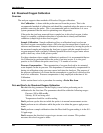
Input Calibration
166 UDA2182 Universal Dual Analyzer Product Manual January 2009
8.8 Dissolved Oxygen Calibration
Overview
The analyzer supports three methods of Dissolved Oxygen calibration:
Air Calibration - is done with the probe removed from the process. This is the
recommended method of calibration and should be completed unless the process set-up
prohibits removing the probe. This is recommended prior to installation as it saves
system parameters that are used in optimizing error diagnostics.
If the probe has just been removed from a sample low in dissolved oxygen, it takes
longer to complete a calibration than that of a probe that is already near ambient
conditions (sample high in dissolved oxygen).
Sample Calibration - Sample calibration allows a calibration based on a known
dissolved oxygen concentration where a DO value may be entered that is based on a
reference measurement. Sample calibration is usually executed by leaving the probe in
the measured sample and adjusting the Analyzer to agree with the sample dissolved
oxygen measured with a properly calibrated portable dissolved oxygen meter whose
probe is held very close to the process probe.
For those situations where sample calibration is preferred, it is recommended that an
Air Calibration be performed before the probe is put into service. It is also good
practice to Air Calibrate the probe once every 2 - 4 months of service.
Pressure Compensation - The concentration of oxygen dissolved in air-saturated
water depends on the air pressure. This dependence is automatically compensated for
during air calibration using a pressure sensor built into the Analyzer. The purpose of
the pressure calibration is to insure that the atmospheric oxygen level is known at the
time of air calibration. Pressure compensation is only employed at the time of Air
Calibration.
In this section there is also a procedure for running a
Probe Bias Scan.
Do’s and Don’ts for Dissolved Oxygen Calibration
Do check the key parameters on the Display screen before performing an air
calibration for the first time. The parameters should be within the following ranges:
Pressure: 500 to 800 mmHg
Salinity: 0.0 if not being used
Temperature should be a stable reading
Don’t perform a probe bias test while the probe is in normal measurement service.
Don’t perform an air calibration while the probe is in either the ppm or ppb process
water.
Don’t perform a sample calibration when the Dissolved Oxygen reading is in the 0.0 -
2.0 ppb range.
Don’t measure the dissolved oxygen in gas streams or air streams. This product
measures dissolved oxygen in water.


















